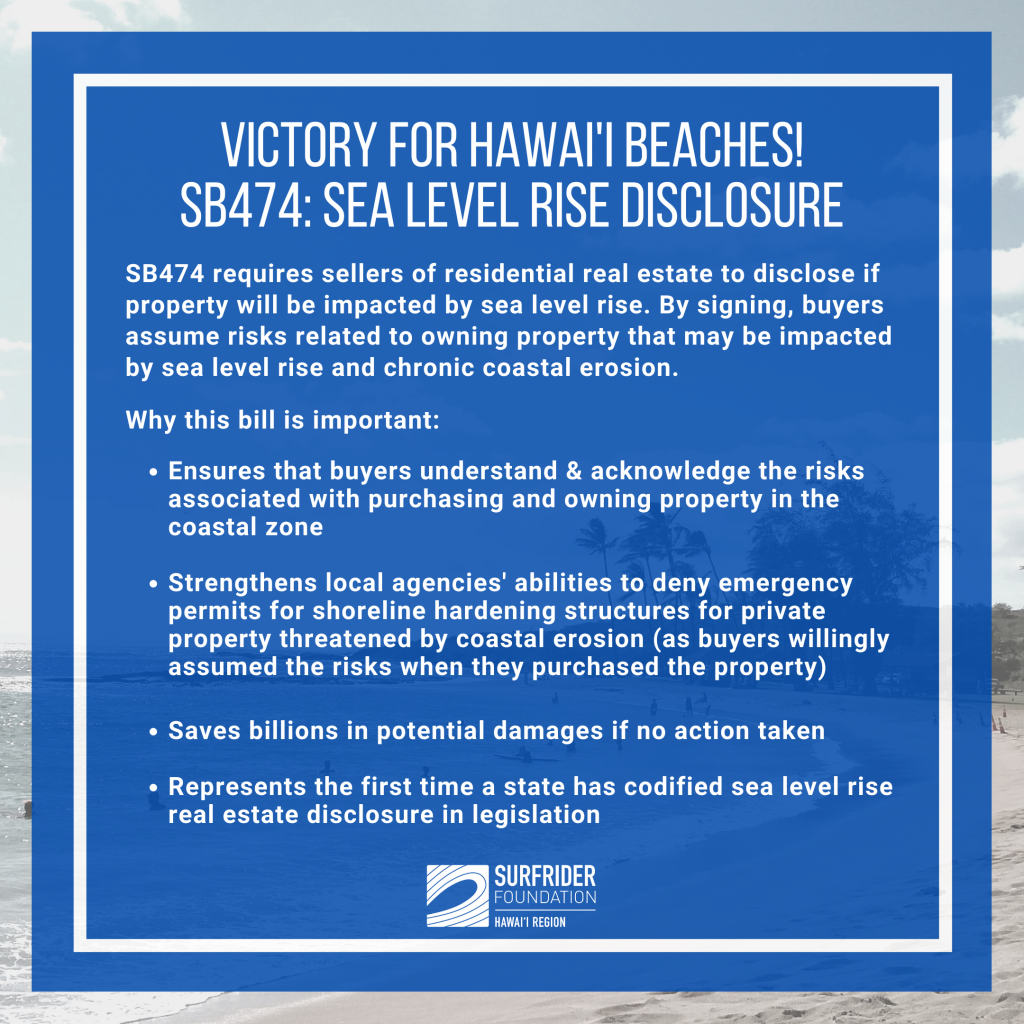
SB474: Sea Level Rise Disclosure Bill
With the passage of SB474 on July 6, 2021, Hawai’i became the first state to codify sea level rise real estate disclosure in legislation. SB474 requires sellers of residential property to disclose whether the property lies within the sea level rise exposure area and thus if the property is at risk from sea level rise and/or coastal erosion. By signing a sea level rise disclosure statement, buyers acknowledge the assumption of these risks.
Our coastlines need protecting
Coastlines and sandy beaches across Hawaiʻi face imminent and increasing threat from coastal hazards such as climate change, rising sea levels and coastal erosion. These coastal hazards threaten the public trust beach areas and billions of dollars of public and private property. In 2017, the Hawaiʻi Sea Level Rise Vulnerability and Adaptation Report (SLR report) estimated that 6,500 structures will be chronically flooded, 28 miles of coastline will become impassable, and 20,000 residents will be displaced with a 3.2 meter rise in sea level.
Additionally, according to a recent study, we are at imminent risk of losing 40% of Hawaiʻi’s sandy beaches and proactive management is necessary to preserve and protect these public trust lands.
Compounding these sobering statistics is a severe lack of information to property buyers about living and owning property in the coastal zone. In many cases, coastal property owners seek to protect their homes from large waves and coastal erosion through a variety of shoreline hardening methods including sea walls and sand bags. These structures prevent the natural flow of sand, exacerbating beach loss. Mandating sea level rise disclosure statements at the point of sale for real estate transactions is both an important and pragmatic action to take.
The importance of SB474
- Ensures that buyers understand/acknowledge the risks associated with purchasing and owning property in the coastal zone;
- Strengthens the state’s and counties’ abilities to deny emergency permits for shoreline hardening structures for private property threatened by coastal erosion (as the buyer willingly assumed the risks when they purchased the property).
- Offers a science-based solution to the problem of sea level rise and coastal erosion.
Additional information about SB474
- Takes effect May 1, 2022
- Properties affected are those that fall within the 3.2-foot sea level rise projections by 2050 (see the Sea Level Rise Exposure Area Map (SLR-XA)).
- Supported by the Hawaiʻi Association of Realtors. Disclosure is already required in flood and tsunami zones and the real estate industry is equipped to adopt an additional disclosure statement into their transactional paperwork.
- The Sea Level Rise Exposure Area Map (SLR-XA) is publicly available online.
- Recent updates in the last year now make it possible to easily identify properties in the Sea Level Rise Exposure Area down to a specific TMK.
- Using SLR-XA is more comprehensive than “beachfront” as it takes into account the combined impacts of SLR (e.g. flooding and coastal erosion).
- The State of Hawaiʻi is required by law to protect public trust lands, which include beaches and coastlines.
Mahalo to Senators KEITH-AGARAN, ENGLISH, GABBARD, KANUHA, LEE, SHIMABUKURO for introducing and supporting SB474.

